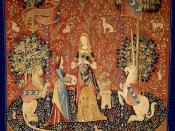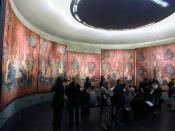Repetition and Tone in "The Lady and the Unicorn" and "The Unicorn in Captivity"
The Lady and the Unicorn and The Unicorn in Captivity are two mysterious tapestries from the European Middle Ages that have inspired many subsequent artists and poets. Two such works inspired by these tapestries are the poems "The Lady and the Unicorn" and "The Unicorn in Captivity", written by May Sarton and Anne Morrow Lindbergh respectively. Each poem focuses on the tapestry that is its named after, but even though they do not focus on the same tapestry, they are very similar to each other in many ways. For instance, both poems make use of repetition and a similar descriptive and contemplative tone which produces the same effect in each work. The descriptive tone and use of repetition in "The Lady and the Unicorn" and "The Unicorn in Captivity" make the scenes depicted appear to be immutable and eternal, which reflects the static nature of the scenes in the tapestries.
Throughout both "The Lady and the Unicorn" and "The Unicorn in Captivity", certain lines are repeated which make the reader aware that the scenes depicted are unchanging.
For example, in "The Lady and the Unicorn", the unicorn repeatedly states that he is forever bowing his head to the lady in the tapestry: "I am the unicorn and bow my head/You are the lady woven into history/And here forever we are bound in mystery" (1-3). By constantly repeating that the unicorn is bowing its head, the speaker draws attention to the fact that this is a static and immutable scene. The speaker uses poetic repetition to emphasize the fact that the images in the poem and the tapestry are fixed and unchanging. Furthermore, the repeated use of the word "history" emphasizes that the moment being...


